S. Korea salvages NK 'satellite' launch debris in West Sea
Investigation to begin to gauge NK's latest developments in missile technology
By Ji Da-gyumPublished : June 16, 2023 - 10:09
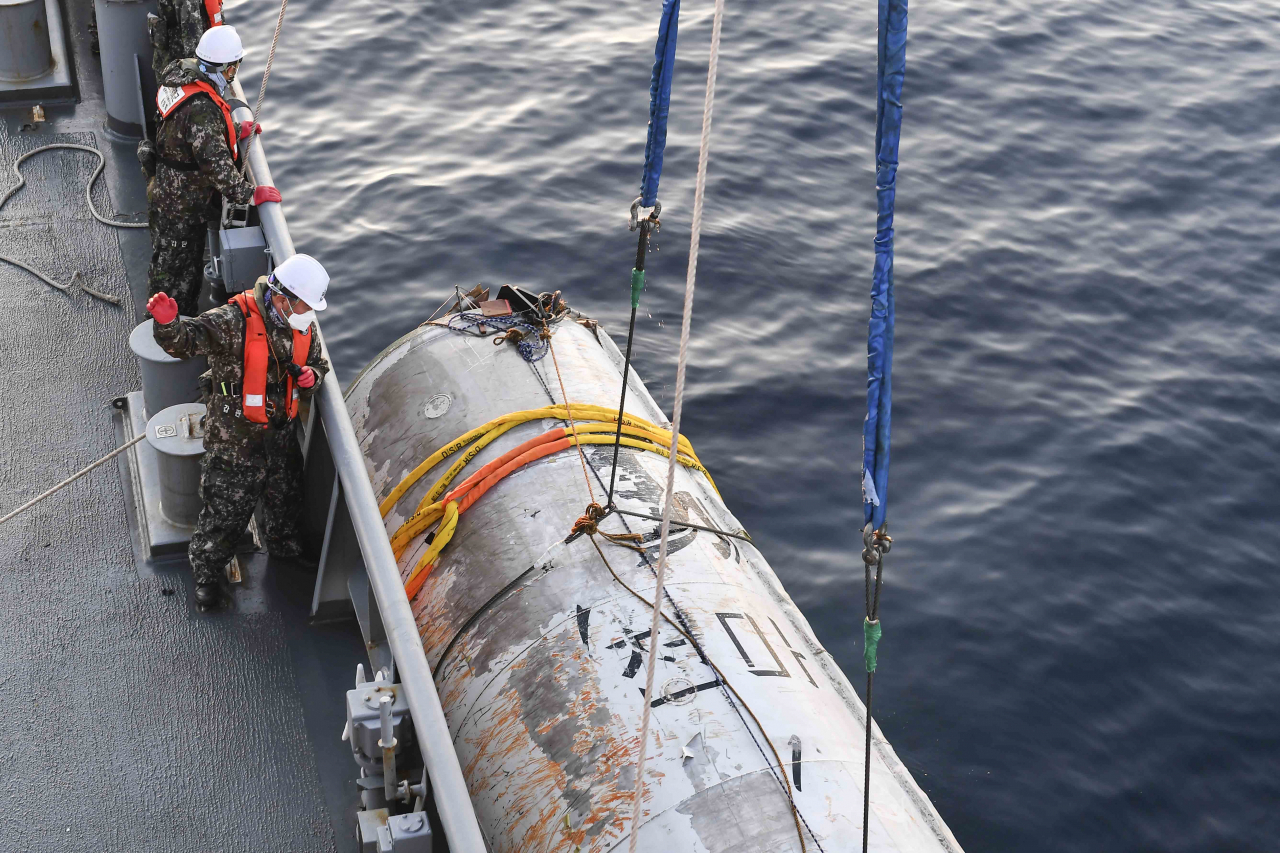
PYEONGTAEK, Gyeonggi Province -- The South Korean military salvaged the wreckage of North Korea's space launch vehicle on Thursday evening for joint investigation and analysis with the United States, aiming to gather the latest information on Pyongyang's missile technologies.
South Korea's Navy retrieved the launch debris, which has been presumed to be the second stage of North Korea's launch vehicle, at around 8:50 p.m. local time, the Joint Chiefs of Staff announced Friday morning. The retrieval of the second stage came 15 days after North Korea launched what it claimed to be the first spy satellite for military purposes on May 31.
The second stage, measuring approximately 12 meters in length and 2.4 meters in diameter, was transported to the South Korean Navy's Second Fleet in the city of Pyeongtaek, Gyeonggi Province, on Friday morning.
The Navy also showcased the white-colored empty ring, which had been salvaged earlier, on the 3,500-ton-class salvage and rescue ship Gwangyang (ATS-II) docked at the Second Fleet. The two pieces of debris were opened to the press for viewing on Friday afternoon during a briefing.
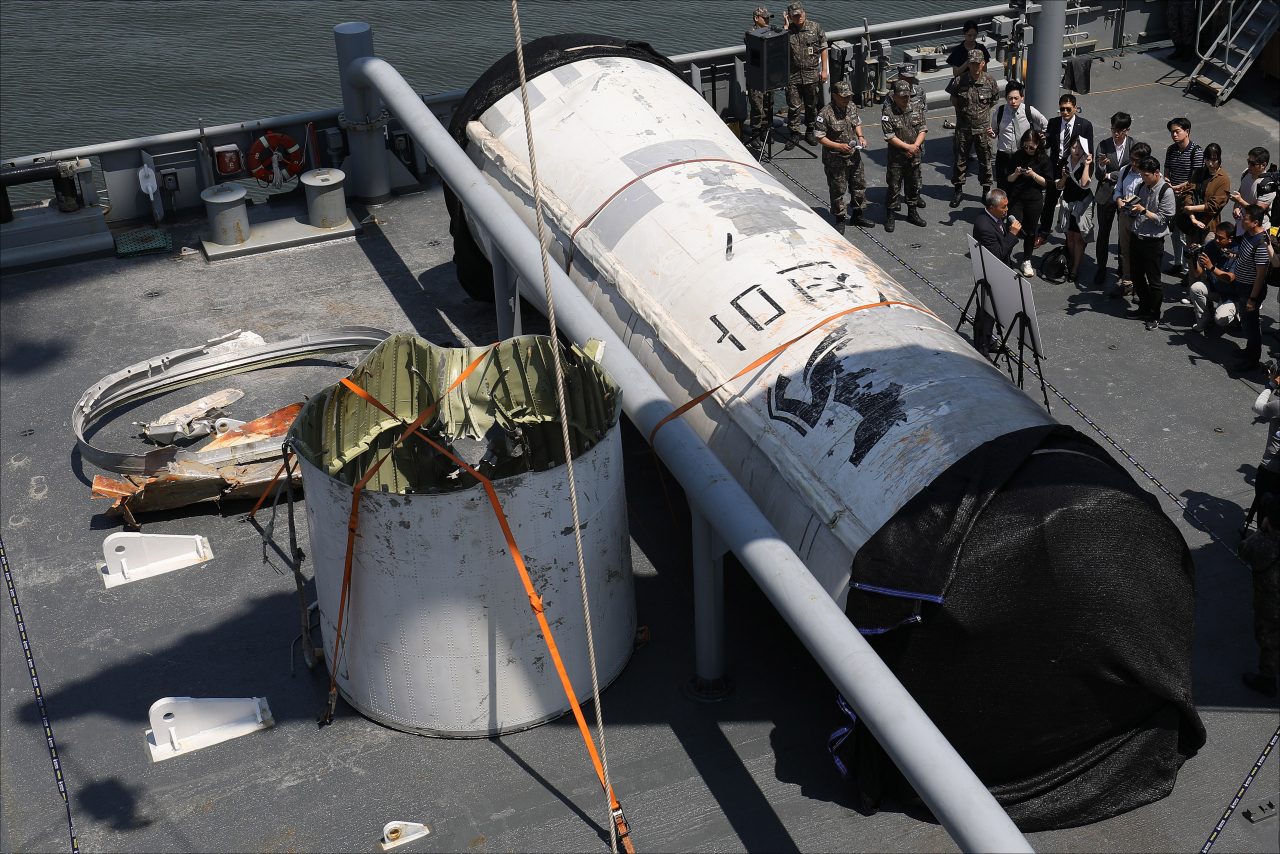
Later in the day, the South Korean Navy was set to transport the launch debris to the headquarters of the Agency for Defense Development in the city of Daejeon, South Korean military officials aboard the Gwangyang said during the briefing.
South Korea's specialized institutions, including the ADD, in collaboration with US agencies such as the Defense Intelligence Agency under the auspices of the US Department of Defense, will conduct a comprehensive analysis of the recovered launch debris.
South Korea and the US reached an agreement to conduct joint research on the debris. This decision was made during in-person talks between South Korean Defense Minister Lee Jong-sup and US Defense Secretary Lloyd Austin, held on the sidelines of the Shangri-La Dialogue in Singapore on June 4.
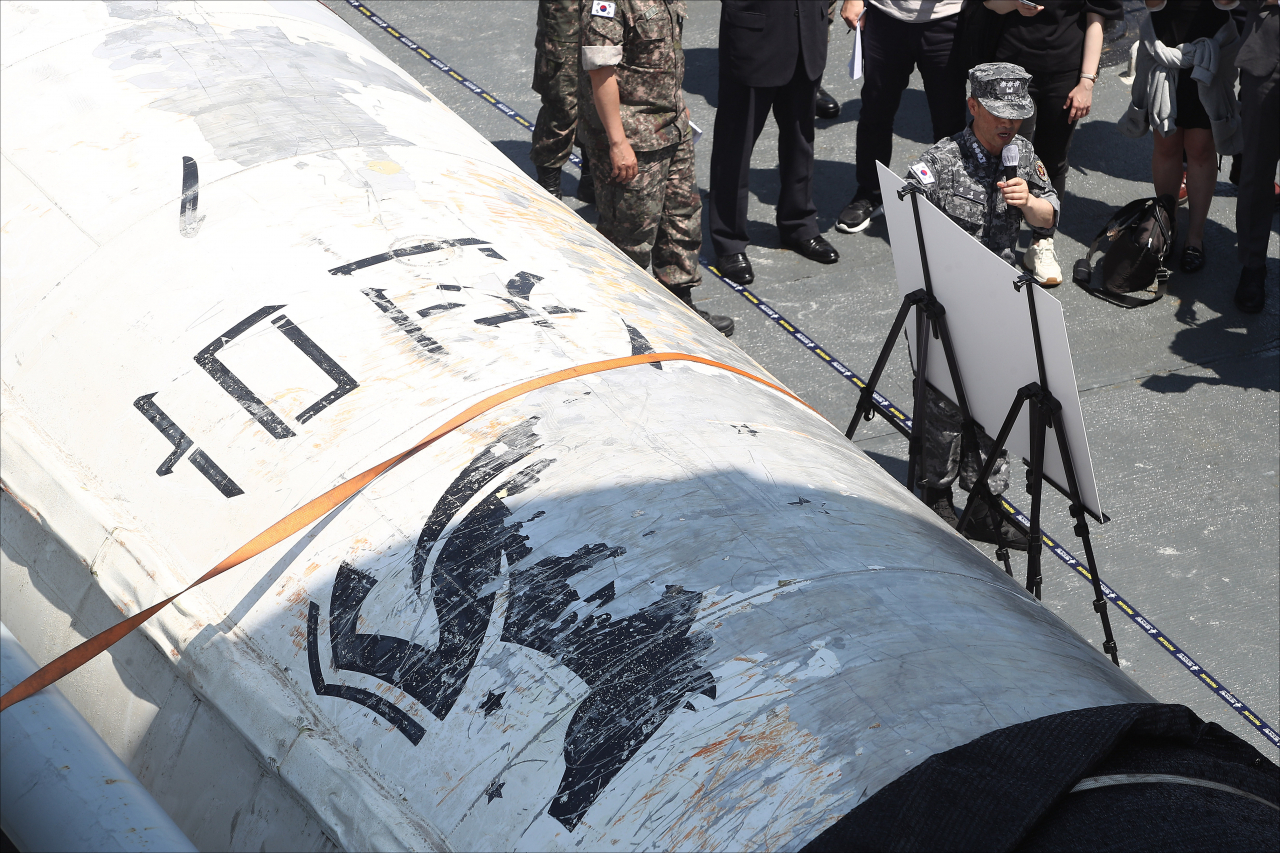
But South Korean military officials declined to confirm whether the launch debris contains crucial components such as fuel and oxidizer during the briefing.
North Korea launched what it said was a "space launch vehicle" dubbed as "Chollima-1" carrying a military reconnaissance satellite named "Malligyong-1" from the area of Tongchang-ri, North Pyongan Province, on May 31.
The second-stage salvaged by the South Korean Navy showed the letter "Cheonma," which can be interpreted as either "heavily horse" in Chinese characters or can be interchanged with "Chollima," along with a picture of a horse. Chollima can be translated into "thousand-li horse," emphasizing its ability to cover a distance of 1,000 li or 500 kilometers in a single day.
However, the South Korean military said that further analysis is required to determine the reason behind North Korea using the name "Cheonma" instead of "Chollima."
During the briefing, the military underscored that it had faced delays and challenges during the salvage operation, primarily due to adverse conditions in the waters such as strong currents and limited visibility
The South Korean Navy initially and promptly located the floating debris near the island in North Jeolla Province, approximately 1.5 hours after the launch at around 8:05 a.m on the date of the launch. Following the launch, North Korea's launch vehicle experienced an abnormal flight and ended up crashing into the waters approximately 200 kilometers west of Eocheong-do in the West Sea.
The military initially utilized a lift bag in their efforts to secure the debris and prevent it from sinking underwater. However, due to the weight of the debris, it eventually sank to the seabed at a depth of 75 meters.
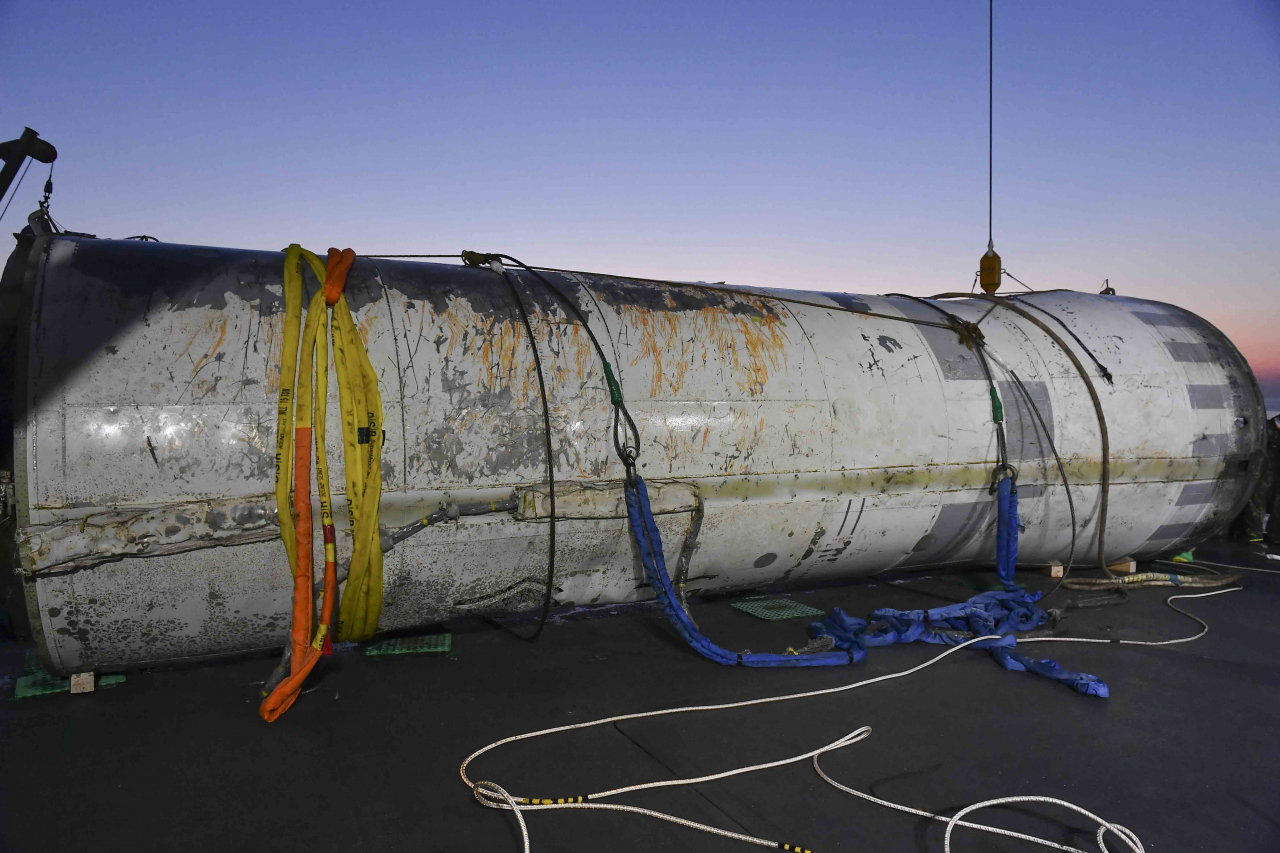
To carry out the salvage and debris search operation, the South Korean military deployed aircraft and around 10 vessels. This included the 3,500-ton-class salvage and rescue ships, Tongyeong (ATS-II) and Gwangyang (ATS-II), along with the 3,200-ton-class submarine rescue ship, Cheonghaejin (ASR).
Scores of deep-sea divers from the South Korean Navy's Sea Salvage and Rescue Unit were deployed from June 3.
But the seabed consists of muddy terrain, while the underwater visibility is approximately 50 centimeters. Another contributing factor to the delay was the size and shape of North Korea's cylindrical launch vehicle.
"First of all, the visibility was very poor, to the extent that I could only see my palm when looking ahead," MSgt. Shin Gyeong-jun, a member of the Sea Salvage and Rescue Unit, told reporters on board Gwangyang, when asked about the most challenging factor during the salvage operation. "As a result, I had to rely solely on my sense of touch to perform the tasks, which made that aspect the most challenging."
Shin further noted that deep-sea divers were able to conduct underwater tasks for approximately 20 to 25 minutes. However, it took around 1 to 2 hours to ascend back to the sea surface, in contrast to the usual 3 to 4 minutes it takes to descend to the bottom.
"Around one-third of the launch debris was buried in the muddy seabed, making us particularly challenging to secure it," Col. Kang Sung-won, the commander of the Navy's Sea Salvage and Rescue Unit, told reporters.
The salvage operation was conducted in three stages.
In the initial phase, deep divers descended to a depth of 75 meters underwater and installed U-shaped loops on the ends of the cylindrical launch debris. These loops served as attachment points for retrieval lines such as heavy-duty ropes and wires.
But during the initial stage of retrieval, the connection between the upper and middle parts of the object could not withstand the pressure and became separated, resulting in damage to some parts of the object. In response, the South Korean Navy installed an additional U-shaped ring around the separated section and used small explosive devices to drill holes in the upper part for attaching wires.
During the second stage, as the salvage progressed and the debris was lifted to a shallower depth of 10 meters, the divers installed additional wires to prevent the debris from sinking back underwater.
In the final phase, the rescue vessel utilized a crane to retrieve the launch debris from the water and load it onto the deck of the vessel. The salvaged debris was then transported to the South Korean Navy's Second Fleet located in Pyeongtaek, approximately 70 kilometers south of Seoul.
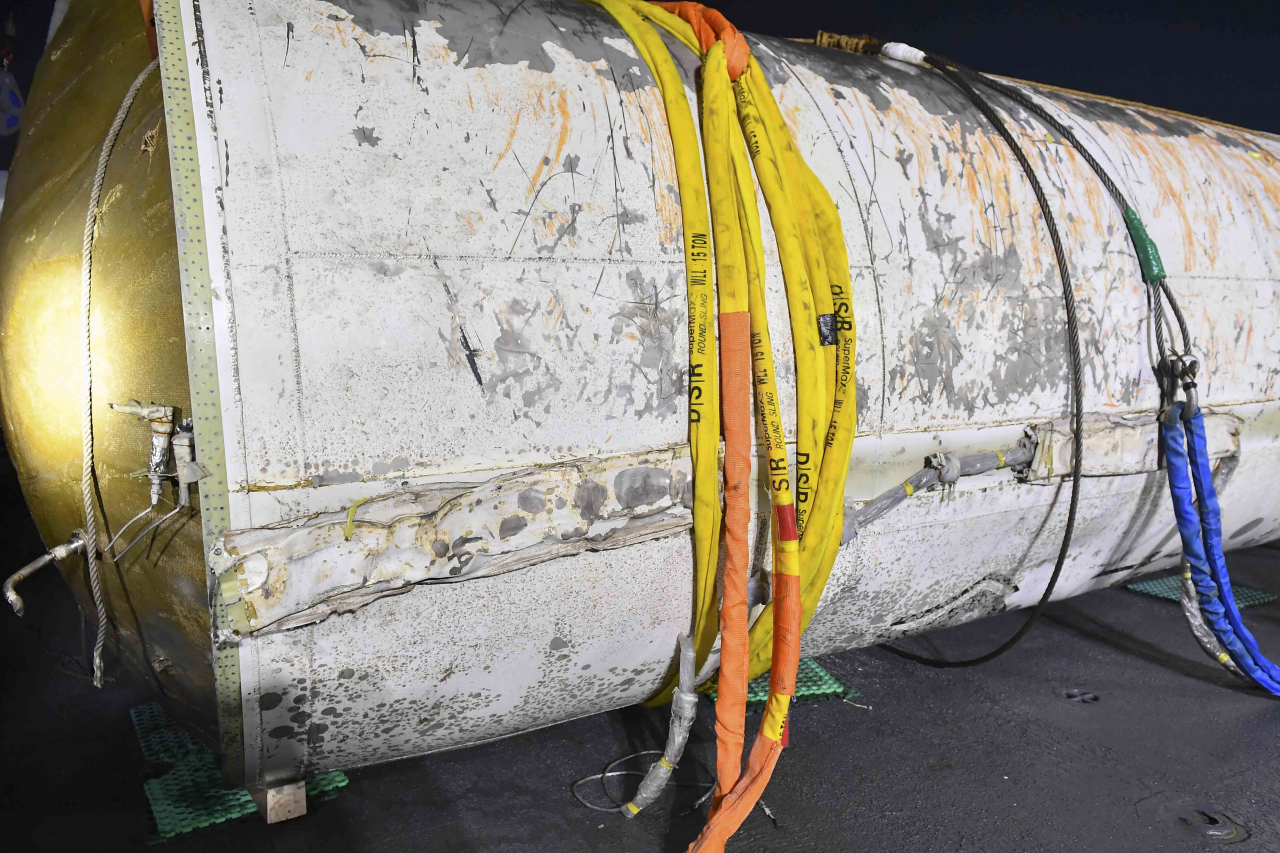
Dr. Chang Young-keun, director of the missile center at the Korea Research Institute for National Strategy, said the photos suggest that the South Korean Navy salvaged the second-stage and interstage section designed to connect first and second stages.
Chang said the second-stage could contain the fuel and oxidizer intact, which is crucial information for understanding the characteristics and performance of the second-stage engine.
"This data will be instrumental in estimating the characteristics of the upper stage of a long-range ballistic missile," Chang said.
Furthermore, the components found in the interstage section "could provide valuable insights into North Korea's technological capabilities and level of domestic production, as well as shed light on whether the country has been procuring foreign components" in violation of UN Security Council resolutions.
South Korea has obtained valuable information about core missile technologies and components, as well as insight into North Korea's missile development plans, from the launch debris of North Korean missiles that they have previously retrieved.
The South Korean military acquired knowledge about North Korea's intention to develop long-range ballistic missiles by examining the debris from the Unha-3 and Kwangmyongsong-4 launch vehicles, which were launched in December 2012 and February 2016, respectively.
The military said it will continue the operation to search for additional debris for analysis including engine and satellite by deploying rescue and search ships and aircraft.






![[Weekender] How DDP emerged as an icon of Seoul](http://res.heraldm.com/phpwas/restmb_idxmake.php?idx=644&simg=/content/image/2024/04/25/20240425050915_0.jpg&u=)


![[KH Explains] No more 'Michael' at Kakao Games](http://res.heraldm.com/phpwas/restmb_idxmake.php?idx=644&simg=/content/image/2024/04/28/20240428050183_0.jpg&u=20240428180321)








![[Herald Interview] Mistakes turn into blessings in street performance, director says](http://res.heraldm.com/phpwas/restmb_idxmake.php?idx=652&simg=/content/image/2024/04/28/20240428050150_0.jpg&u=20240428174656)
